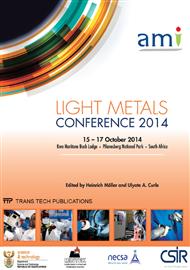p.302
p.311
p.318
p.327
p.333
p.339
p.347
p.357
p.365
Influence of Cooling Path on the Dynamic Transformation of Austenite-to-Ferrite in Low Carbon Manganese Steels
Abstract:
For an effective thermomechanical process control, knowledge of the start and finish temperatures of the austenite transformation is critical. Continuous Cooling uniaxial-Tension (CCT*) is a useful way to measure these values. Therefore, the dynamic transformation of austenite to ferrite (γ → α) was investigated in C-Mn steels to understand the hot ductility behaviour of these steels after varying the cooling paths i.e. simulating “hard” and “soft” cooling rates of the strand during continuous casting. Results show that hard cooling into the dual phase (γ + α) region significantly increases the dynamic transformation temperatures due to a higher driving force owing to double transformation and precipitation of AlN during the process. A comparison of dynamic versus static transformation (Ar3 and Ar1) temperatures and equilibrium transformation temperatures gives a better understanding of the contribution of strain to transformation during casting or hot deformation.
Info:
Periodical:
Pages:
333-338
Citation:
Online since:
October 2014
Authors:
Price:
Сopyright:
© 2014 Trans Tech Publications Ltd. All Rights Reserved
Share:
Citation:


